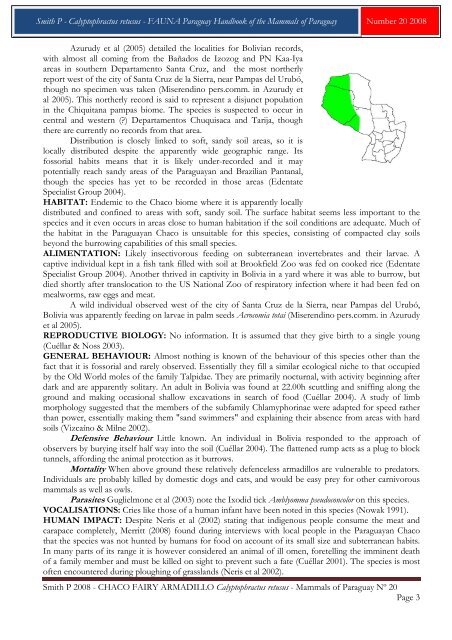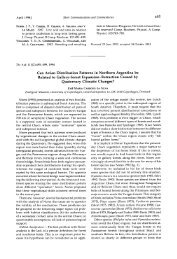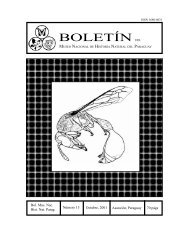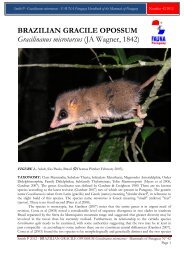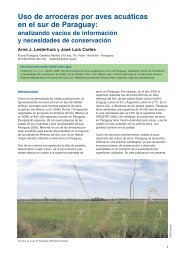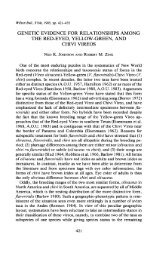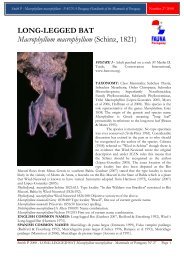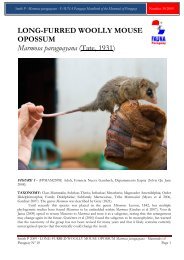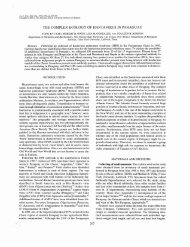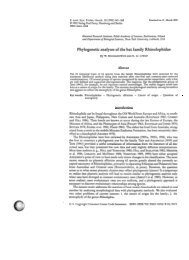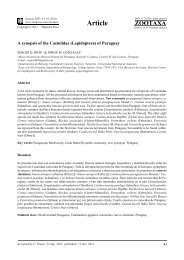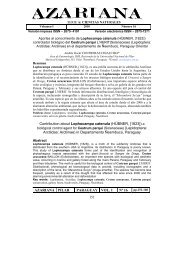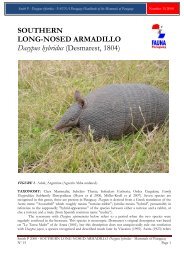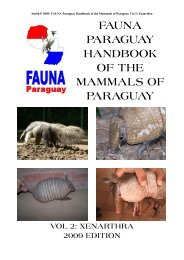CHACO FAIRY ARMADILLO Calyptophractus ... - FAUNA Paraguay
CHACO FAIRY ARMADILLO Calyptophractus ... - FAUNA Paraguay
CHACO FAIRY ARMADILLO Calyptophractus ... - FAUNA Paraguay
You also want an ePaper? Increase the reach of your titles
YUMPU automatically turns print PDFs into web optimized ePapers that Google loves.
Smith P - <strong>Calyptophractus</strong> retusus - <strong>FAUNA</strong> <strong>Paraguay</strong> Handbook of the Mammals of <strong>Paraguay</strong> Number 20 2008<br />
Azurudy et al (2005) detailed the localities for Bolivian records,<br />
with almost all coming from the Bañados de Izozog and PN Kaa-Iya<br />
areas in southern Departamento Santa Cruz, and the most northerly<br />
report west of the city of Santa Cruz de la Sierra, near Pampas del Urubó,<br />
though no specimen was taken (Miserendino pers.comm. in Azurudy et<br />
al 2005). This northerly record is said to represent a disjunct population<br />
in the Chiquitana pampas biome. The species is suspected to occur in<br />
central and western (?) Departamentos Chuquisaca and Tarija, though<br />
there are currently no records from that area.<br />
Distribution is closely linked to soft, sandy soil areas, so it is<br />
locally distributed despite the apparently wide geographic range. Its<br />
fossorial habits means that it is likely under-recorded and it may<br />
potentially reach sandy areas of the <strong>Paraguay</strong>an and Brazilian Pantanal,<br />
though the species has yet to be recorded in those areas (Edentate<br />
Specialist Group 2004).<br />
HABITAT: Endemic to the Chaco biome where it is apparently locally<br />
distributed and confined to areas with soft, sandy soil. The surface habitat seems less important to the<br />
species and it even occurs in areas close to human habitation if the soil conditions are adequate. Much of<br />
the habitat in the <strong>Paraguay</strong>an Chaco is unsuitable for this species, consisting of compacted clay soils<br />
beyond the burrowing capabilities of this small species.<br />
ALIMENTATION: Likely insectivorous feeding on subterranean invertebrates and their larvae. A<br />
captive individual kept in a fish tank filled with soil at Brookfield Zoo was fed on cooked rice (Edentate<br />
Specialist Group 2004). Another thrived in captivity in Bolivia in a yard where it was able to burrow, but<br />
died shortly after translocation to the US National Zoo of respiratory infection where it had been fed on<br />
mealworms, raw eggs and meat.<br />
A wild individual observed west of the city of Santa Cruz de la Sierra, near Pampas del Urubó,<br />
Bolivia was apparently feeding on larvae in palm seeds Acrocomia totai (Miserendino pers.comm. in Azurudy<br />
et al 2005).<br />
REPRODUCTIVE BIOLOGY: No information. It is assumed that they give birth to a single young<br />
(Cuéllar & Noss 2003).<br />
GENERAL BEHAVIOUR: Almost nothing is known of the behaviour of this species other than the<br />
fact that it is fossorial and rarely observed. Essentially they fill a similar ecological niche to that occupied<br />
by the Old World moles of the family Talpidae. They are primarily nocturnal, with activity beginning after<br />
dark and are apparently solitary. An adult in Bolivia was found at 22.00h scuttling and sniffing along the<br />
ground and making occasional shallow excavations in search of food (Cuéllar 2004). A study of limb<br />
morphology suggested that the members of the subfamily Chlamyphorinae were adapted for speed rather<br />
than power, essentially making them "sand swimmers" and explaining their absence from areas with hard<br />
soils (Vizcaíno & Milne 2002).<br />
Defensive Behaviour Little known. An individual in Bolivia responded to the approach of<br />
observers by burying itself half way into the soil (Cuéllar 2004). The flattened rump acts as a plug to block<br />
tunnels, affording the animal protection as it burrows.<br />
Mortality When above ground these relatively defenceless armadillos are vulnerable to predators.<br />
Individuals are probably killed by domestic dogs and cats, and would be easy prey for other carnivorous<br />
mammals as well as owls.<br />
Parasites Guglielmone et al (2003) note the Ixodid tick Amblyomma pseudoconcolor on this species.<br />
VOCALISATIONS: Cries like those of a human infant have been noted in this species (Nowak 1991).<br />
HUMAN IMPACT: Despite Neris et al (2002) stating that indigenous people consume the meat and<br />
carapace completely, Merritt (2008) found during interviews with local people in the <strong>Paraguay</strong>an Chaco<br />
that the species was not hunted by humans for food on account of its small size and subterranean habits.<br />
In many parts of its range it is however considered an animal of ill omen, foretelling the imminent death<br />
of a family member and must be killed on sight to prevent such a fate (Cuéllar 2001). The species is most<br />
often encountered during ploughing of grasslands (Neris et al 2002).<br />
Smith P 2008 - <strong>CHACO</strong> <strong>FAIRY</strong> <strong>ARMADILLO</strong> <strong>Calyptophractus</strong> retusus - Mammals of <strong>Paraguay</strong> Nº 20<br />
Page 3


